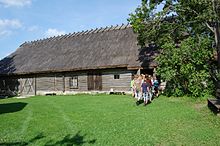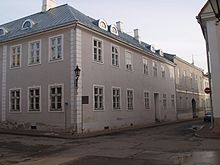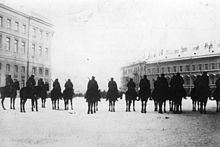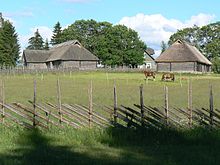Tõde yes õigus
Tõde ja õigus ( Truth and Law ) is the title of a novel pentalogy by the Estonian writer Anton Hansen Tammsaare (1878–1940). The Estonian original of the five volumes was published between 1926 and 1933.
Appear
Anton Hansen Tammsaare had already published a dozen books, mostly short stories, before he set about writing his magnum opus after his first novel, Kõrboja peremees (1922). After much preparatory work, Tammsaare wrote the first part of the novel within five months, the first volume was published in 1926 by the Tartu “Noor Eesti” publishing house. After a slight delay, the same publishing house published the second volume in 1929, while the second edition of the first volume appeared at the same time. The following volumes appeared in 1931, 1932 and 1933.
The book was repeatedly reprinted in exile and in Estonia and is one of the classics of Estonian literature. 1981–1983 the novel was published as volume 6–10 of the eighteen-volume collected works of Tammsaare.
There are two versions of the third volume, as Tammsaare made an abridged version for the Latvian and German translation of it at the end of the 1930s. Since he wrote “For the Estonian” on the title page of this abridged version, it was later used for all new editions of the novel, although the author had not published an authorized new version during his lifetime.
action
The five-part novel has a total of around 675,000 words and is roughly on the scale of Tolstoy's War and Peace . The number of people appearing is also very high with around 170 figures.
In keeping with its all-encompassing title, the novel is a large-scale painting of the genesis of Estonian society from the end of the third quarter of the 19th century to the beginning of the 1930s. The main character is the farmer's son Indrek Paas, whose fate is followed from birth.
The first volume (1926; German under the title Wargamäe , 1938, again 1970, see below) begins with the arrival of Indrek Paas' parents, Andres and Krõõt, on a newly acquired farm. The author uses a lot of autobiographical material and describes the laborious existence of his father, which in addition to draining a swamp also includes the constant quarrels with a lazy and devious neighbor. This Pearu, as his name is, later became the symbol for the envious neighbor, and he also had a real role model, namely the grandfather of the writer Ilmar Sikemäe , who was the neighbor of Tammsaare's father. Furthermore, Indrek's childhood was certainly modeled on the author's childhood. Indrek is the son of Andres' second wife, the former maid Mari. After Krõõt's death in childbed, she moved to Andres to look after the children, but this drove her husband to suicide. The novel is rich in such personal blows of fate: illness and death, despair and suicide, rifts and God's punishments take up a lot of space.
The second volume (1929; German under the title Indrek , 1939, again 1980) describes Indrek's school days in Tartu and also shows autobiographical features, as the school director Maurus pictured here with Hugo Treffner , the head of the private school , ran the Tammsaare from 1898 to 1903 visited, resembles. After the famous school novel Kevade ('Spring', 1912/13) by Oskar Luts , which is one of the most popular books in Estonia, this was the second important novel to be set in the school. This tradition was later continued by Jaan Kross with his novel Wikmani poisid (1988). At school Indrek comes into contact with Germans, Russians and Latvians, he immerses himself in the world of knowledge, reads and learns a lot and deals with existential issues. He also makes his first acquaintances with women, both desirable and pitiable, such as the little paralyzed Tiina, whom he wants to comfort with a vague promise of marriage. Ultimately, in this phase, he also loses the faith in God that was inherited from home.
The third volume (1931; included in German as the second part in Indrek , again in 1983 under the title Wenn der Sturm is silent ) takes place entirely in the revolutionary year of 1905 , which Indrek experienced in the capital Tallinn . Here he comes into contact with revolutionary circles, reads socialist literature and sympathizes with them. On the one hand, he was intoxicated by the idea of political freedom; on the other hand, he soon turned away from the revolutionaries, disappointed, because he saw nothing but destruction and no constructive construction in their arson on German property. At the same time, he becomes entangled in a tragic love affair that ends with the death of the woman after she learns of her father's activity as an informant. At the end of the book, Indrek temporarily goes back to his parents' farm. The aftermath of the revolution can also be felt here: his brother, who temporarily proclaimed a republic in the courtyard, is shot by a punitive battalion, and his father is flogged. His mother Mari is terminally ill and begs Indrek to put an end to her suffering, which Indrek does with the help of a pharmacist friend from town.
In the fourth volume (1932; German under the title Karins Liebe , 1940, again in 1988) Indrek is in Tallinn after a leap in time of around twenty years in the early years of the Estonian Republic. Indrek works as a teacher and is financially secure, but his private life is unfulfilled and his marriage to Karin is in ruins. The side effects of modern society, including the economic crisis, speculation and the sensational press, make life difficult for Indrek. In the affect, Indrek shoots his wife, but does not hit her fatally. In the subsequent trial, Indrek got away with a suspended sentence, but the marriage finally failed and in the end Karin got caught in a tram. Indrek, who did not recognize the paralyzed girl from the second volume in the housemaid Tiina, especially since she has recovered, flees to the country.
In the fifth volume (1933; German under the title Return to Wargamäe , 1941, again in 1989) Indrek, disappointed with life, seeks consolation on his parents' farm. His father is still alive, but has meanwhile ceded the farm to his daughter and son-in-law. This leaves a lot of time for conversations with the father, which ultimately lead to Indrek throwing himself into physical work and thereby giving his life meaning again. The drainage plans originally forged by the father are now being continued by the son, so that the father can soon die calmly. Finally, Tiina appears in the country and reveals himself, so that Indrek finally redeems his marriage promise from over a quarter of a century and wants to shape his future together with Tiina.
Reception and meaning
The start of the novel cycle in Estonia got off to a slow start. Only gradually did the multi-layered and sprawling text conquer its now superior position. Today it is not only compulsory reading in school, but parts of it are also repeatedly brought to the theater stage. The work received its greatest ennoblement from the fact that it served as a model for reality: the flow regulation made by Indrek in the last volume was a pure fiction of the author and had no real model. In the 1960s, however, the river was actually regulated at Tammsaare's birthplace, so that novel and reality were brought back into harmony.
Tammsaare himself stated in a letter to his Finnish translator Erkki Reijonen that the novel is about the basic questions of human existence, which can be summarized under the four denominators nature, metaphysics, society and the individual. He wrote the letter on February 19, 1933, i.e. at a time when the last volume had not yet appeared: "In my work I tried to see people once in their quarrel with the country, once with God (what nowadays it is almost a laughing stock), once with society, once with his private life and his virtues (whichever quarrel is usually the most difficult and harrowing). From this phase of development or struggle, a person must either come to despair or to resignation ( that is, of course, in the event that man takes life and its questions seriously), and this final result (despair or resignation) must represent the fifth delivery of the novel, which must also be the natural end of the novel. "
filming
In 2019, the Estonian director Tanel Toom made a film adaptation of pentalogy. The film was selected as Estonian entry for the 2020 Academy Awards in the Best International Film category and made it into the shortlist of ten films in December 2019.
Translations
translation to German
Since Tammsaare was no longer a stranger when the first volume was published, it is not surprising that a German newspaper in Estonia published a review in the same year as the first volume, recommending the novel for translation into Western European languages. However, this review initially had no concrete consequences, and Tammsaare himself endeavored to translate his work into German by signing a contract with a German translator as early as 1930.
Nevertheless, a contract with a German publisher was not concluded until 1937, namely with the Berlin publisher Holle & Co , which was managed by the Dutchman Gérard Du Ry van Beest Holle . Since the publisher did not want to commit to the publication of the entire pentalogy, a separate title was chosen for the first volume, which led to the fact that the following volumes also received their own headings:
- Wargamae. Roman from Estonia. Justified translation from Estonian by Edmund Hunnius. Berlin: Holle & Co. Verlag 1938. 491 pp.
- Indrek. Roman from Estonia. Legitimate translation from Estonian by Edmund Hunnius. Berlin: Holle & Co 1939. 673 pp.
- Karin's love. Roman from Estonia. Legitimate translation from Estonian by Edmund Hunnius. Berlin: Holle & Co 1940. 386 pp.
- Return to Wargamae. Roman from Estonia. Legitimate translation from Estonian by Edmund Hunius [sic]. Berlin: Holle & Co 1941. 427 pp.
In research it has been stressed at times that the inclusion of Tammsaare's main work in Germany was “under a bad star”, which means the Nazi era and the Second World War. That is only partially correct, because firstly the reception of the opening volume was extremely positive (see below), and secondly, the political circumstances paradoxically benefited the reception: Since Anglo-American literature could no longer be received in Germany (because it was ultimately anti-war) , one turned to other literatures, including smaller and less well-known ones.
The first volume received over sixty reviews in the German press and nearly all of the reviews were positive. Since the publisher drew a parallel on the blurb to the novel The Peasants by Polish Nobel Prize Laureate Władysław Reymont from 1924, a noticeable number of reviewers mentioned this work. Other authors with whom Tammsaare was regularly compared were Knut Hamsun , Fyodor Michailowitsch Dostojewski and Lev Nikolajewitsch Tolstoy . Hamsun's repeated effort has even resulted in the Slovak translation being authored by Anton Hamsun Tammsaare speaking!
One of the most important reviews came from the pen of the German exile author Ernst Weiß and appeared in the Paris daily newspaper on June 10, 1939. Weiß counts Tammsaare's work among the “great achievements confirmed by a tremendous external success” and sees in the novel a work “that tells of a completely different world - and of a completely different kind of mastery and humanity.” He emphasizes, that Tammsaare can compete with Tolstoy: “... if the following volumes are at the height of the first, the whole will represent a work that is not too far behind war and peace. In a certain point he is even a bit superior to Tolstoy, he has real humor ... "
The positive reception of the first volume by literary criticism led the publisher to continue the series and, despite the onset of war, also completed it. While the second volume received plenty of positive reviews, the reviews ebbed afterwards. Overall, however, the reception of the novel in Germany can be viewed as positive.
This is further supported by the fact that a complete new translation was organized in the GDR, which appeared in five volumes:
- Wargamae. Roman from Estonia. Translation from Estonian by Dr. AE Graf. Leipzig: Paul List Verlag 1970. 586 pp.
- Indrek. Novel. Translation from Estonian by Eugenie Meyer. With an afterword by Eerik Teder. Leipzig: Paul List Verlag 1980. 472 pp.
- When the storm is silent. A novel about 1905. Translation from Estonian by Eugenie Meyer. Leipzig: Paul List Verlag 1983. 291 pp.
- Karin's love. Novel. Translation from Estonian by Eugenie Meyer. Leipzig, Weimar: Gustav Kiepenheuer Verlag 1988. 526 pp.
- Return to Wargamae. Novel. Translation from Estonian by Eugenie Meyer. Leipzig, Weimar: Gustav Kiepenheuer Verlag 1989. 517 pp.
Translations into other languages
In addition to German, the complete novel is available in five other languages:
- Latvian : Zeme un mīlestība . Ar autora atlauju tulkojusi Elīna Zālīte. Rīgā: Valtera un Rapas akc. 1936, 438 p .; Zeme un mīlestība. II . Tulk. Elīna Zālīte. Rīgā: Valtera un Rapas akc. 1936, 554 p .; Zeme un mīlestība. III . Tulk. Elīna Zālīte. Rīgā: Valtera un Rapas akc. 1936, 422 pp.
- French : La Terre-du-Vouleur . Adapt. franc. d'Elisabeth Desmarest. Paris: Trémois 1944. 400 pages; Indrek . Adapt. franc. de Ellen Terrence. Paris: Trémois 1946. 282 p .; Jours d'émeutes . Adapt. franc. de Gilberte Audouin-Dubreuil. Paris: Trémois 1947. 277 p .; Les amours de Karin . Adapt. franc. de Gilberte Audouin-Dubreuil. Paris: Trémois 1947. 294 p .; Return à la Terre-du-Vouleur . Adapt. franc. de Gilberte Audouin-Dubreuil. Paris: Trémois 1948. 320 pp.
- New translation in French: La Colline-du-Voleur. Vérité et Justice tome 1 . Trad. by Jean Pascal Ollivry. Paris: Gaïa 2009. 682 p .; Indrek. Vérité et Justice tome 2 . Trad. by Jean Pascal Ollivry. Paris: Gaïa 2009. 510 pp .; Jours d'émeutes. Vérité et justice tome 3 . Trad. by Jean-Pierre Minaudier. Paris: Gaïa 2009. 322 p .; Indrek and Karin. Vérité et Justice, tome 4 . Trad. by Eva Toulouze. Paris: Gaïa 2010. 526 p .; Return à la Colline-du-Voleur. Vérité et Justice tome 5 . Trad. by Jean Pascal Ollivry. Paris: Gaïa 2010. 500 pp.
- Czech : Dva rody z Vargamäe . Přel. Věra Kružiková. Praha: Svoboda 1976. 401 p .; Indrek z Vargamäe . Přel. Věra Kružiková. Praha: Svoboda 1980. 312 p .; Indrek mezi vzbouřenci . Přel. Nadežda Slabihoudova; doslov napsal dr. Vladimir Macura. Praha: Svoboda 1981. 191 p .; Indrek a Karin . Přel. Nadežda Slabihoudova. Praha: Svoboda 1982. 246 p .; Návrat na Vargamäe . Přel. Nadežda Slabihoudova. Praha: Svoboda 1983. 264 pp.
- Russian : Варгамяэ . Πеревод с эстонского Р. Минны. Москва: Художественная литература, 1966. 598 p .; Индрек. Πеревод с эстонского Марии Кулишовой и Ольги Наэль. Москва: Художественная литература 1966. 708 p .; Любовь Карин . Перевод: А. Томберга и В. Шацкова. Москва: Художественная литература 1967. 350 p .; Возвращение . Перевод с эстонского Л. Тоом. Москва: Художественная литература 1967. 374 pp.
- Finnish : Totuus ja oikeus 1. Maan lupaus. Suomentanut ja saatesanan kirjoittanut Juhani Salokannel. Helsinki: Otava 2002, 773 p .; Totuus ja oikeus 2nd koulutie . Suomentanut ja saatesanan kirjoittanut Juhani Salokannel. Helsinki: Otava 2004. 575 p .; Totuus ja oikeus 3. Surmatulet . Suomentanut Juhani Salokannel. Helsinki: Otava 2007. 348 p .; Totuus ja oikeus 4. Kuolemantanssi . Suomentanut ja saatesanan kirjoittanut Juhani Salokannel. Helsinki: Otava 2011. 668 p .; Totuus ja oikeus 5. Kotiinpaluu . Suomentanut ja saatesanan kirjoittanut Juhani Salokannel. Helsinki: Otava 2013. 634 p .; Before the war, Volume 1 (1932) and Volume 5 (1935) had been translated into Finnish by Erkki Reijonen.
Partial volumes have been published in some languages:
- Dutch, Volumes 1 and 2: Wargamäe . Uit het Estisch vertaald by Mr. Anna C. van den Bosch en Henriëtte Roosenburg. 's-Gravenhage: De kern 1941. 319 p .; Indrek . Roman uit Estonia. Vertaald door Co Kars. 's-Gravenhage: De kern 1941. 358 pp.
- Hungarian, Volume 1: Orcád verítékével. Ford. Bereczki Gábor. Budapest: Európa 1967. 586 pp.
- Polish, Volume 1: Wargamäe . Przeł. [from German] Janina Nowak. Poznań: Wydawnictwo Poznańskie 1971. 216 pp.
- Slovak, Volume 1: Dva rody z Vargamäe . Prel. [from Russian] Ružena Dúbravová. Bratislava: Slovenský spisovateĺ 1973. 555 pp.
- Lithuanian, Volumes 1 and 2: Tiesa ir teisingumas I . Iš estų kalbos Danutė Sirijos Giraitė. Vilnius: Vaga 2009. 558 p .; Tiesa ir teisingumas II . Iš estų kalbos Danutė Sirijos Giraitė. Vilnius: Vaga 2017. 414 pp.
- Bulgarian, Volume 3: Правда и справедливост . превод от естонски Дора Янева-Медникарова. Ruse: Avangard 2011. 252 pp.
- English Volume 1: Truth and Justice. Andres and Pearu. Transl. by Inna Feldbach and Alan Peter Trei. Haute Culture Books 2014. 642 pp.
Quotes
- “Work and toil, then love will come by itself…. "(Volume 1 of the German translation, 1938, p. 488)
- "It's not great stuff, it's the real truth," Indrek explained. “All over the world this has long been known, because there is more education and justice, only here in Russia have we stayed behind. Once all people are educated, no one will believe in God anymore. I also told Mr. Maurus that, I will tell you and I will tell everyone, because that is the truth. "(Volume 2 of the German translation, 1939, pp. 379-380)
- "Human culture develops in two directions, on the one hand the personality is cultivated and provided with all the legal rights and obligations that come with it, on the other hand this personality is degraded to the public market animal that anyone can touch who feels like it." (Volume 3 of the German translation, 1940, p. 366)
literature
- Epp Annus: Eetilised hoiakud AH Tammsaare romaanis "Tõde ja õigus", in: Vikerkaar 1–2 / 2005, pp. 138–145.
- Angela Burmeister: Estonian literature in Germany and in the German Democratic Republic from the beginning of the 20th century [sic] to the end of the eighties. [Unprinted] Dissertation A for obtaining the academic degree of doctor in a branch of science (doctor philosophiae) submitted to the Scientific Council of the Wilhelm-Pieck-Universität Rostock. February 1990.
- Philippe Chardin: Kaunis romaan eesti “õnnetust teadvusest”: Tammsaare “Tõde ja õigus”, in: Looming 6/2014, pp. 839–849.
- Cornelius Hasselblatt : 1905 in the Estonian novel, in: Norbert Angermann , Michael Garleff , Wilhelm Lenz (eds.): Baltic provinces, Baltic states and the national. Festschrift for Gert von Pistohlkors on his 70th birthday. Münster: Lit Verlag 2005, pp. 321–342 (publications of the Baltic Historical Commission 14)
- Cornelius Hasselblatt: Estonian literature in German translation. A reception story from the 19th to the 21st century . Wiesbaden: Harrassowitz 2011.
- Elizabeth Judas: Russian influence on Estonian literature. A study on Jakob Tamm and Anton H. Tammsaare . Los Angeles: Wetzel Publishing Co., Inc. 1941.
- Mart Kuldkepp: Aleksander Kesküla kirjandustegelasena, in: Keel ja Kirjandus 57 (2014), pp. 897–910.
- Karl Mihkla: AH Tammsaare elutee yes looming . Tartu: Noor-Eesti kirjastus 1938.
- Mihkel Mutt : Tamjevski ja Dostosaare, in: Looming 1/2014, pp. 72–89.
- Helene Siimisker: AH Tammsaare . Lühimonograafia. Tallinn: Eesti Riiklik Kirjastus 1962. (Eesti kirjamehi)
- Erna Siirak: AH Tammsaare in Estonian Literature . Tallinn: Perioodika 1978.
- Nikolai Sillat: A curiosity with three languages, in: Estonia 4/1987, pp. 156–159.
- Eerik Teder: Kummaline teekond "Kuritööst ja karistusest" "Tõe ja õiguseni", in: Eesti filoloogia poolsajand Teaduste Akadeemias. Tallinn: Eesti Keele Instituut 1997, pp. 354-358.
- Eerik Teder / Elem Treier: "Tõe ja õiguse" tõlkimisest Soomes. AH Tammsaare kirjad Erkki Reijonenile, in: Keel ja Kirjandus 21 (1978), pp. 43–56; 98-107; 160-169; 230-237
- Tõde ja õigus: kirjandus, mis kunagi valmis ei saa . “Tõe ja õiguse” I köite esmailmumise 80. aastapäevale pühendatud konverentsi ettekanded 8. XII 2006. Koostaja Maarja Vaino. Tallinn: AH Tammsaare Museum 2007.
- Elem Treier: Tammsaare ja tema “Tõde ja õigus” . Tallinn: Olion 2000.
- Jaan Undusk : Tammsaare, Baudelaire yes De Quincey. "Tõe ja õiguse" esimese osa motost, in: eel ja Kirjandus 34 (1991), pp. 491–495.
- Maarja Vaino: Tammsaare "Tõde ja õigus" Foucault 'võimukäsitluse raamistikus, in: Keel ja Kirjandus 47 (2004), pp. 681-696.
- Maarja Vaino: Irratsionaalsuse poeetika AH Tammsaare loomingus . Tallinn: Tallinna Ülikool 2011. (Tallinna Ülikooli humanitaarteaduste dissertatsioonid. 26)
- Maarja Vaino: Shakespeare ei kirjutanud “Tõde ja õigust”. “Tõde ja õigus” 90, in: Keel ja Kirjandus 59 (2016), pp. 794–795.
- Ilmar Vene: Tammsaare yes Dostojevski. Maailmapiltide kõrvutus, in: Keel ja Kirjandus 50 (2007), pp. 345–356.
Individual evidence
- ↑ Karl Mihkla: AH Tammsaare elutee ja looming . Tartu: Noor-Eesti kirjastus 1938. p. 97.
- ↑ AHTammsaare: Kogutud teosed 1–18. Tallinn: Eesti Raamat 1978-1993.
- ↑ Redigeerimismärkusi, in: AHTammsaare. Tõde ja õigus III. (Kogutud teosed 8). Tallinn: Eesti Raamat 1982, p. 253.
- ↑ Cf. Cornelius Hasselblatt: 1905 in the Estonian novel, in: Norbert Angermann, Michael Garleff, Wilhelm Lenz (eds.): Baltic provinces, Baltic states and the national. Festschrift for Gert von Pistohlkors on his 70th birthday. Münster: Lit Verlag 2005, pp. 328–329 (writings of the Baltic Historical Commission 14).
- ↑ Cornelius Hasselblatt : History of Estonian Literature. From the beginning to the present. Berlin, New York: Walter de Gruyter 2006, p. 459.
- ↑ Eesti kirjanduse ajalugu. IV. Köide, 1. Tallinn: Eesti Raamat 1981, p. 323.
- ↑ Epp Annus, Luule Epner, Ants Järv, Sirje Olesk, Ele Süvalep, Mart Velsker: Eesti kirjanduslugu. Tallinn: Koolibri 2001, p. 286.
- ↑ Eerik Teder / Elem Treier: "Tõe ja õiguse" tõlkimisest Soomes. AH Tammsaare kirjad Erkki Reijonenile, in: Keel ja Kirjandus 21 (1978), p. 56.
- ↑ “Tõde ja õigus” asub Oscarit püüdma . In: jarvateataja . Retrieved August 21, 2019.
- ↑ Oscars: Estonia Selects 'Truth and Justice' for Best International Feature Category . In: The Hollywood Reporter . Retrieved August 21, 2019.
- ↑ 10 Films Make Shortlist for Oscars' Best International Film . In: The New York Times . Retrieved December 17, 2019.
- ^ Arthur Behrsing: A new Estonian novel, in: Revaler Bote No. 279, December 6, 1926; an Estonian translation of the article can be found in Keel ja Kirjandus 1977, pp. 620–622.
- ↑ Cornelius Hasselblatt: Estonian literature in German translation. A reception story from the 19th to the 21st century. Wiesbaden: Harrassowitz 2011, p. 132.
- ↑ Cornelius Hasselblatt: Estonian literature in German translation. A reception story from the 19th to the 21st century. Wiesbaden: Harrassowitz 2011, p. 134.
- ^ Friedrich Scholz: Anton Hansen Tammsaare (1878-1940). Estonian prose between realism and modernity, in: Anton Tammsaare: The living puppets. Selection of prose. Munich: Wilhelm Fink 1979, p. 43; similar to Nikolai Sillat: A curiosity with three languages, in: Estonia 4/1987, p. 156.
- ↑ Marek Tamm: Kollaboratsionismi paradoksid: Estonian kirjandus okupeeritud Prantsusmaal (1940-1944), in: Looming 8/2001, pp 1210-1218.
- ↑ Most of the reviews are recorded in: Cornelius Hasselblatt: Estonian Literature in German Language 1784–2003. Bibliography of primary and secondary literature. Bremen: Hempen Verlag 2004, pp. 137-138.
- ↑ http://www.ester.ee/record=b2416735*est
- ↑ A new master. AH Tammsaare, »Wargamä«., Reprinted in: Ernst Weiß: The art of storytelling. Essays, articles, writings on literature. Frankfurt / M .: Suhrkamp 1982, pp. 440–442 (Suhrkamp Taschenbuch 799), all quotations from here.
- ↑ Cornelius Hasselblatt: Estonian literature in German translation. A reception story from the 19th to the 21st century. Wiesbaden: Harrassowitz 2011, pp. 131–139.
- ↑ Cornelius Hasselblatt: Estonian literature in German translation. A reception story from the 19th to the 21st century. Wiesbaden: Harrassowitz 2011, pp. 167–171.






